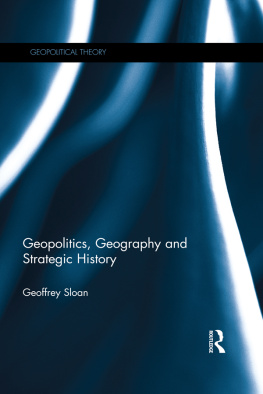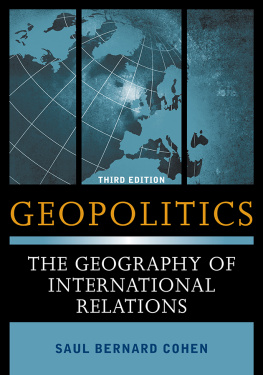ROUTLEDGE LIBRARY EDITIONS: POLITICAL GEOGRAPHY
Volume 8
GEOPOLITICS
GEOPOLITICS
PATRICK OSULLIVAN
First published in 1986
This edition first published in 2015
by Routledge
2 Park Square, Milton Park, Abingdon, Oxon, OX14 4RN
and by Routledge
711 Third Avenue, New York, NY 10017
Routledge is an imprint of the Taylor & Francis Group, an informa business
1986 Patrick OSullivan
All rights reserved. No part of this book may be reprinted or reproduced or utilised in any form or by any electronic, mechanical, or other means, now known or hereafter invented, including photocopying and recording, or in any information storage or retrieval system, without permission in writing from the publishers.
Trademark notice: Product or corporate names may be trademarks or registered trademarks, and are used only for identification and explanation without intent to infringe.
British Library Cataloguing in Publication Data
A catalogue record for this book is available from the British Library
ISBN: 978-1-138-80830-0 (Set)
eISBN: 978-1-315-74725-5 (Set)
ISBN: 978-1-138-81029-7 (Volume 8)
eISBN: 978-1-315-74961-7 (Volume 8)
Publishers Note
The publisher has gone to great lengths to ensure the quality of this reprint but points out that some imperfections in the original copies may be apparent.
Disclaimer
The publisher has made every effort to trace copyright holders and would welcome correspondence from those they have been unable to trace.
Geopolitics
Patrick OSullivan
1986 Patrick OSullivan
Croom Helm Ltd, Provident House, Burrell Row,
Beckenham, Kent BR3 1AT
Croom Helm Ltd, Suite 4, 6th Floor,
6476 Kippax Street, Surry Hills, NSW 2010, Australia
British Library Cataloguing in Publication Data
OSullivan, Patrick
Geopolitics.
1. Geography, Political
I. Title
320. 12 JC319
ISBN 0709919344
Filmset by Mayhew Typesetting, Bristol, England
Printed and bound in Great Britain by Mackays of Chatham Ltd, Kent
CONTENTS
Geography and Politics
The premiss of this book is that geography matters in the relations between states, be they friendly or hostile. The strength of sympathetic and influential ties between the governments of nations is as much a matter of geographic distance as of political and cultural distance. Certainly in tracing both the causes and courses of wars, distance and space count for a lot at the grand strategic level. More locally in time and space, the details of geography provide the immediate setting for deadly conflict and strongly affect the outcome of war.
Whether we like it or not, the crux of international politics is war. We punctuate history with the violent contests of powers. The immediate circumstance of these outbreaks of killing and destruction is most usually contested turf. Political authority is conceived of as extending over some portion of the earths surface and the competition of those with power is over whose writ runs where. The domains of significance obviously extend beyond the limits of the nation state and the most serious conflicts today, from the viewpoint of mans survival, arise in the ill-defined setting of the spheres of influence of the superpowers.
Even if we account importance in the more mundane terms of the use of our resources, we spend a lot of time, effort and material in fighting each other or getting ready to do so. The number of people whose lives are dedicated to war, to making weapons and the exertions and ingenuity put to these ends, uses up a large share of the worlds wealth. In our political dealings with each other we frequently suspend the moral rules-we ordinarily live by and are willing to kill and maim other people and destroy their property, or to threaten these things, in order to enable our leaders to get their way. Violence has been a ready resort and the preparation for war is a major feature of most civilised societies. Old men prepare and induce young men to kill the enemy. In the past the enemy was usually other young men but now it includes women, children, the old and the earth itself. The main reason for going to war has been to command more territory, and this remains the chief source of conflict. The greatest danger to our lives and well-being does not arise from the abstract clash of ideologies, but from the collision of the forces of the great powers or their clients over some piece of land. Whether the self-justifying rhetoric which accompanies such clashes is revolutionary or democratic, the occasion of conflict is the control of territory. The fundamental dimension of conflict between nations is geographical. Geopolitics is the study of the geography of relations between wielders of power, be they rulers of nations or of transnational bodies. The limiting state of these relations is war and, no matter how we may abhor its wastefulness, this has been the main means of resolving the competitive process. War provides the negative image of affairs between peoples, and thus delineates the extent of peaceful co-operation or competition in the world.
There are now over 4 million people from 45 of the worlds 164 nations involved in combat, with up to 5 million people killed in fighting over the last three years. There is a concentration of turmoil at the pivot of the continents where Africa and Eurasia meet and a wider scatter beyond in Africa, South Asia and Latin America. The mainsprings of these outbursts of bloodletting and fire are mostly local. They are sparked by the frictions of social, economic and political change and personal ambition and are not in essence elements in any worldwide plan for conquest and domination. At times these local conflicts have been exploited by the government of one powerful state to embarrass that of another power. Or politicians and officials have sought to cover up their own lack of foresight, their ineptitude or inability to control affairs in their client states, by claiming that the troubles were mischievously generated by their protagonists as part of their campaign of conquest. Spokesmen for the USSR have claimed that the American government is behind the Afghan mujahedin, while Jeane Kirkpatrick put the El Salvador guerrilla war in somewhat confused global context when she announced that an eastern offensive on our southern borders was not tolerable to the west. Some holders of power and office may actually believe in the simple theories of global politics in which they couch their foreign policy pronouncements. Whether these anathemas hurled at the opposition arise from a heartfelt belief or are merely a face-saving device, they contort the big powers attitudes to others conflicts. These are treated not on the basis of judgement of local rights and wrongs, but as an outlet for ambition and competitive strutting.
Mental Maps
In reacting to tension and strife around the world, the foreign policy establishments of the great powers do seem to have generalised images of political geography in their minds. These images are occasionally articulated as powerful, allegorical maps. The lines of their divisions of the globe clearly transcend the frontiers of nation states. Maps of political geography delineating the worlds 164 countries are obviously missing something. For the politicians and functionaries of the great powers there are, at least, mental maps of our and their territory which supersede national boundaries, with an anymans land lying between them. It is evident that the lines of demarcation on these mental maps do not coincide as between the two main camps, and the overlap of claims brings the dangerous might of the continent-spanning powers too close to each other for everyones comfort.







